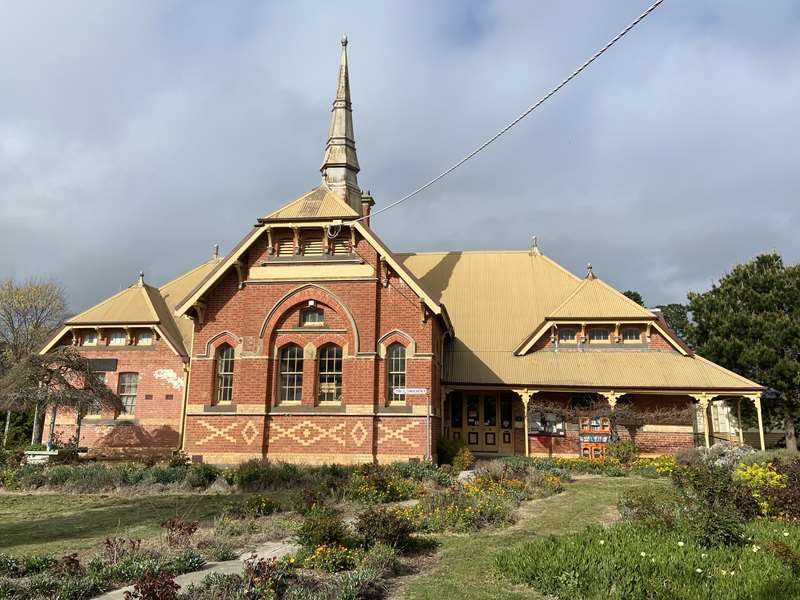Clunes - The Lee Medlyn Home of Bottles


The Lee Medlyn Home of Bottles consists of over six thousand old and historical bottles and other related objects. Dating from 1500 A.D. to present time the bottles cover all types of beverages including beer, wine & spirit, aerated waters, preserves, condiments, ginger beer, chemist and drug companies.
You'll find some very rare and significant pieces in the collection.
The collection is housed in the decommissioned South Clunes State School which was, for over 45 years, used as the Clunes Interknit Mill.

There is a playground, old tram and toilets in the grounds outside.

Opening Hours:
Open 4 days 11am-4pm Thurs to Sun or by appointment - contact Barb Webb (03) 5345 3865, Jan Turner (03) 5345 3346 or Yvonne Yates (03) 5343 5281
Cost:
Admission is $3 per person. Under 12 years are free.
George Lee Medlyn
George Lee Medlyn was born in 1921 in St Arnaud Victoria.
Most of his life was spent as a sheep farmer and wool classer. However it was whilst fossicking for gold that he discovered his lifelong passion for old bottles, many of which were found alongside the old diggings. After the death of his first wife in 1981, Lee sold his farm and retired and became a resident of Clunes.
Lee later met his companion of 13 years Joyce Harrison at an antique and collectibles fair where she was working as a judge. In 1985 with storage of his bottles becoming a huge problem, they purchased the former State School No 136, and began a new venture, the Bottle Museum.
They shared a love of travelling and collecting that took them to many places throughout Australia enabling them to add selected pieces of interest to the collection, which led to the present display of many rare and historical items.
Following his death in August 1994, Lee bequeathed the collection and building to the Shire of Talbot and Clunes. This generous gift to the town is managed for the community by a committee of management made up of volunteers appointed by Hepburn Shire Council.
History of the Site
Former State School No.136 was built in 1881 on the site of an earlier temporary school. The building was designed by Education Department architect Henry Bastow and the new school was opened on 1 January 1882.
This design was first used at Horsham, and includes an early example of a large school verandah. Moreover, the manner in which the verandas are integral with the main roof gives the Horsham group a very distinctive appearance.
In 1892 state school No. 136 amalgamated with State School No. 1552, and was used as the infant school. It closed its doors in 1922, and was later used as a mill for the Clunes Knitting and Manufacturing Company Limited.
The original building has had numerous additions, which relate to its use as a mill. Much of the original slate roof has been replaced by corrugated iron and, presumably in the process, many roof details have been changed. Many of the original pine trees on the boundary still remain however the picket fence has been removed. Architecturally this is the most sophisticated of the schools erected locally and despite its conversion to a knitting mill these qualities have been retained. It now houses the Clunes Bottle Museum.
Water on the early gold fields was often too precious to drink freely! Diggers often took refreshments at sly grog shops. In 1868 Ernest Eberhard established a successful cordial and aerated water manufactory at Clunes. Lucky bottle-collectors may have an Eberhard bottle in their collection, or they can be viewed at the Clunes Bottle Museum, which houses the largest display of rare bottles in the southern hemisphere.
George Lee Medlyn, a sheep farmer and a top Merino sheep fleece judge, purchased the school building in 1985. In 1989 he opened the Bottle Museum to the public which he later bequeathed to the Shire of Talbot & Clunes.
Historic Tram
History of Trams in Melbourne
Trams are a major part of Melbourne's transport history As of 2017, there were 250 kilometres of tram tracks and 493 trams in service, covering 24 routes and 1763 stops
Trams have operated in Melbourne since 1885, firstly as horse drawn trams (which operated until 1923) and cable trams (with cable tram lines being progressively converted to electric trams from 1924 and ceasing altogether in 1940). Cable trams were connected to an underground cable which moved in a loop, drawn by steam engines situated in a powerhouse located on the tram route. Each cable tram contained a "grip" mechanism which gripped or released the tram from the continuously moving cable (which ran at a constant speed).
Electric tram systems were first introduced in 1906 in St Kilda and Essendon and gradually replaced the existing horse drawn and cable tram lines on other routes, before expanding to the vast network of tram routes we have today.
Electric trams get their power from overhead power lines, which can be seen throughout Melbourne, with the electricity being sent to the motors beneath the tram via an attachment on the tram roof which connects to the power lines. The trams have driver's controls at both ends. When a tram reaches the end of its route, the driver walks to the other end of the tram in order to drive it in the other direction.
Our Tram
Our tram - number 865 - is a W class (sub-class SW6) tram and was the 15th of 120 SW6 trams built in the period 1939 to 1950. Our tram first ran on the tram network on 22 November 1940. Our tram was withdrawn from service in Melbourne in the 1990s and placed into storage. It was eventually donated to the Ballarat Tramways Museum before being relocated to where it sits today in February 2020.
Location
70 Bailey Street, Clunes 3370 Map
✆ (03) 5345 3896
Web Links
→ clunesmuseum.org.au/whats-on/the-lee-medlyn-home-of-bottles-collection/
→ Lee medlyn home of bottles on Facebook









